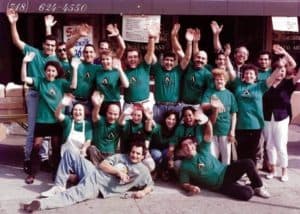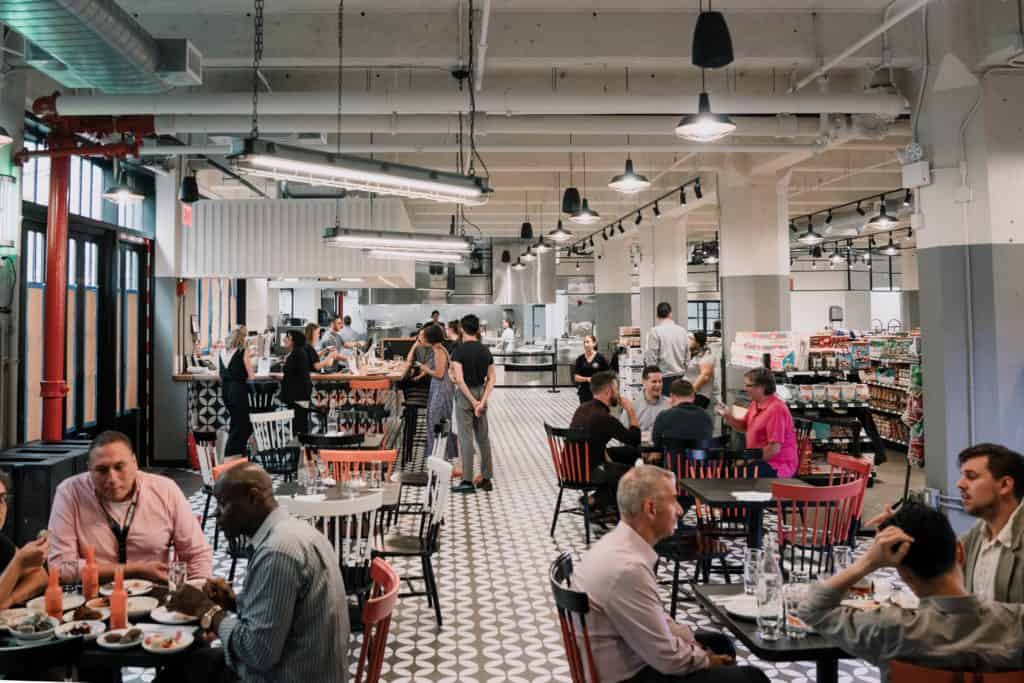Sahadi’s, the James Beard Award-winning specialty grocery that spans three storefronts on Atlantic Avenue, has become a part of Sunset Park’s commercial fabric after opening in Industry City two months ago. It’s just a few blocks from their production facility, which houses an 18-foot-tall roaster that freshly roasts top quality nuts and seeds, stores thousands of pallets of imported delicacies and supplies accounts across the country.
“I think the best part of Industry City has been the terrific collaborations with other tenants and building management. It is a chance for us to showcase all of the things we always wished we could do at [the Atlantic Avenue location],” says lifelong Brooklyn resident and Sahadi’s co-owner Christine Sahadi Whelan. “Each day is fun as we grow into our new space.”

Located at 34 35th Street, the latest store features a sit-down cafe with 80 seats, a Mediterranean-focused wine bar, house-baked pita bread and made-to-order saj. Saj, the name of both the type of bread and the domed griddle used to make this super thin and tender concoction (texture and appearance lies somewhere between a crepe and a panini), is particular to Lebanon. The dough is baked atop the dome, spread with zaatar and handpicked toppings like lamb shawarma and Persian cucumbers, and then quickly rolled and sliced. This is one of the only public and operational sajs in New York City.
History and family
The store originally had its roots in Manhattan’s Little Syria, with Abrahim Sahadi opening A. Sahadi & Co. on Washington Street in 1895. Back then it was a Middle Eastern store with mostly Middle Eastern costumers, according to Whelan. His nephew Wade Sahadi, who emigrated from Lebanon in the 1920s, worked with his uncle and later relocated the shop to Brooklyn in 1948. The move to Brooklyn happened due to the construction of the Brooklyn Battery Tunnel, which opened to traffic in 1950. Wade’s son Charlie took over the business in 1967, with the help of his wife Audrey and his siblings Bob and Richie.

Now, more than a hundred years later, Sahadi’s offers fine grains, spices, freshly house roasted nuts and more as it caters to customers of different ethnicities. Their fridge cases have smoked fish, pâtés and specialty cheeses from around the world. Customers can find 30 dishes like homous, kibben and kebabs – prepared daily with traditional techniques and changed seasonally – at the deli and bakery sections. Charlie’s children, Ron Sahadi and Christine Sahadi Whelan, and her husband Pat Whelan have been running Sahadi’s since the ’90s.
Christine, who grew up roaming around the store, says family and traditions are at the heart of Sahadi’s operations, no matter the site.
“At each of our locations on Atlantic Avenue, Industry City and our warehouse in Sunset Park there is always a family member there running the day-to-day operations,” she says. “Being a true family in a family business helps us to connect to our core values and traditions. Each of our staff and team members know that we are truly one large team and family. Many of our employees have been with us for decades and that adds to the family feel of the locations.”
But she notes that the success of Sahadi’s can also be credited to the customers.
“One of the unique and special things of being part of a third-generation family business – almost fourth – is that so many of our customers are also third-generation customers. As we have grown and changed, we love the tradition of seeing the children and grandchildren of our customers becoming part of our retail family.”

What to expect
Whelan tells us that her family is looking forward to working with Industry City’s Innovation Lab and activating an event space with classes and themed dinners. She is also publishing her first cookbook – tentatively titled Flavors of the Sun – in January 2020.
“We have a lot of great things in the pipeline for the next few years and we are excited to put this into action,” she adds.
For more information and updates, follow @sahadis on Instagram, Twitter, and Facebook.
Top photo of Sahadi’s in the 1900s, from Sahadi’s Fine Foods website.
Author
-

George Fiala has worked in radio, newspapers and direct marketing his whole life, except for when he was a vendor at Shea Stadium, pizza and cheesesteak maker in Lancaster, PA, and an occasional comic book dealer. He studied English and drinking in college, international relations at the New School, and in his spare time plays drums and fixes pinball machines.
View all posts
George Fiala has worked in radio, newspapers and direct marketing his whole life, except for when he was a vendor at Shea Stadium, pizza and cheesesteak maker in Lancaster, PA, and an occasional comic book dealer. He studied English and drinking in college, international relations at the New School, and in his spare time plays drums and fixes pinball machines.










